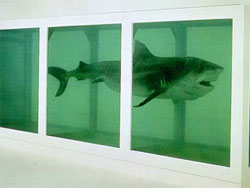
Despite Lehmann Brothers filing for bankruptcy earlier yesterday there wasn't even a whiff of the credit crunch at Sotheby's in London where a staggering £70-odd million was spent in a matter of minutes to snap up the works of artist Damien Hirst.
Damien Hirst's auction at Sotheby's, London, marks radical innovation. The breakthrough isn't, of course, in the art on view. The novelty lies in the method of sale.
Nobody, as far as I know, has ever brought to the saleroom a large batch of new work directly from the studio, or multiple fabrication locations, in Hirst's case. It misses out a whole stage in the conventional game - the dealer's role.
Normally it is years, if not decades, before a work of contemporary art comes under the hammer. Wise old art-world hands have wandered around the display muttering about a stroke of genius, which it is. And of course, financially, it could all go wrong. We'll know the answer to that on the days of the auction, Sept. 15 and 16.
One thing about the whole enterprise is immediately impressive: its sheer scale. It would be wrong to compare this to a private gallery show held in an auction house.
The size of it, 10 large rooms and more than 200 works, is more like a major career retrospective at Tate Modern.
It feels about the same dimension as the Cy Twombly exhibition there this summer. But that contained the work of a long lifetime. This is all signed and dated 2008. Amazing.
But also good? As a show of Hirst's work, this is distinctly odd. It contains new examples of just about every type of work he's ever created: spot paintings, spin paintings, pickled animals, skulls, display cabinets, and so on. Indeed, it has them in new permutations: spin paintings with skulls stuck on them, for example.
A shark-in-formaldehyde work sold for £9.6 million, titled “The Kingdom,” the black-framed tank containing a 7-foot, 9-inch tiger shark had been expected to fetch between 4 million pounds and 6 million pounds.
Source: Bloomberg
With the empirical value of everything, never more than now, under such scrutiny... what better time to dig deep for that useful dead shark you’ve needed so badly.
Added to which, are buyers taking a ticket to stand in line to lampoon themselves? Surely Hirst’s hugely expensive “Golden Calf” included its buyer in the work’s envelope by fulfilling the False Prophets sermon to which the work so assiduously gestured.
Although I’m sure the argument can be parried with the artist’s £50million Crystal Skull as a highly priced reminder that you can't take it with you.
Whatever; as long as Hirst’s buyers get the opportunity to tell people at the Groucho Club how much they paid for it... I don’t suppose it really matters.


